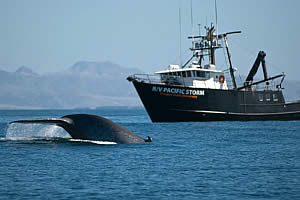
Researchers on the Pacific Storm, tagged blue whales near the Channel Islands of California in 2006. credit Craig Hayslip
An unprecedented decade-long study of apex predators in the Pacific Ocean found a wider range of distribution among some species than previously thought, unknown relationships between other species, and the importance of biological "hotspots" to the survival of most of these sea creatures.
The field program, dubbed Tagging of Pacific Predators â€" or TOPP â€" looked at 23 species from 2000-09 and included researchers from multiple institutions.
Results of the study are being published this week in the journal Nature.
"One thing that quickly became apparent is that there are many similarities among top predators in the California Current System," said Bruce Mate, director of the Marine Mammal Institute at Oregon State University and co-author on the study. "There is a strong overlap in territory, for example, between blue whales and tuna. Blue whales eat krill; the tuna eat fish that eat the krill.
"But the krill, and the ocean conditions that promote its abundance, are key to both species," added Mate, who directed the cetacean portion of the TOPP study. "When there are hotspots of krill or other food, the apex predators need to find them."
Most of these hotspots result from upwelling, or the fertilization of surface waters with nutrient-rich deeper water as a result of wind-driven mixing. One such biological hotspot occurs just west of Santa Barbara, Calif., where the wind comes around Point Conception and triggers strong upwelling.
"When the winds there died, we watched whales eat literally all of the available food in three days, and then they just took off," Mate said. "Most of them moved to the Farallon Islands near San Francisco, which is another productive feeding area. Blue whales likely know these hotspots from experience. Instead of waiting for upwelling to renew the krill population, they'll travel 400 miles in three days to find a new food source."
The study also found, however, that some species have more difficulty with poor ocean productivity, as often happens during El Niño events. Coastal birds also depend on krill, and during an El Niño in 2006-07, most of their hatchlings failed, the researchers noted.
Pinnipeds â€" including seals and seal lions â€" normally experience a successful birth rate of 80 percent, but in El Nino years, that drops to 20 percent. "Most of the offspring die," Mate said, "because the mothers cannot produce enough milk."
The TOPP study was the first ocean basin-scale study of marine predator distribution and movement ever conducted, and the massive amount of data collected will help resource managers develop effective ocean protection strategies, the researchers say.
The study underscores the importance of apex predators in different ecosystems, noting how the loss of bluefin tuna and porbeagle sharks in the Atlantic Ocean contributed to the near-extinction of cod and similar species.
Mate, a pioneer in the use of satellites to track endangered whales and other species, has been studying blue whales for decades and has been featured in the National Geographic Magazine and the National Geographic Channel film, "Kingdom of the Blue Whale." Most of that documentary was shot aboard OSU's research vessel Pacific Storm, which tracked blue whales tagged off California in the fall to their first-ever discovered winter breeding and calving area 500 miles off Costa Rica in an upwelling area.
Blue whales may be unique among large whales in using areas for reproduction where they can continue to feed. Interestingly, the whales do not have just one route for this migration but instead use a variety of offshore routes and variable timing.
Adult blue whales can grow to the length of a basketball court and weigh as much as 25 large elephants combined. A blue whale's mouth could hold 100 people, Mate said, though its diet is primarily one-and-a half-inch long krill. The heart of a blue whale is the size of a small automobile. Scientists say the blue whale is the largest creature to ever inhabit the Earth â€" and it is one of the loudest animals in the sea, capable of making sounds equivalent to those of a jet engine, though at frequencies below human hearing.
Mate and his colleagues also tracked a fin whale for more than a year as part of the TOPP research.
"It did nothing that we expected," he said with a laugh. "Usually, we think large whale species go south for the winter and north in the summer, but this whale spent its winter in the Gulf of Alaska and didn't go south until spring when it went as far south as the tip of Baja, but returned back to the Gulf of Alaska without stopping anywhere. In total, the whale made four trips through a 30-kilometer wide area off Vancouver Island, suggesting a preference for a very precise corridor.
"It's hard to generalize about whale behavior with a small sample size," Mate said. "But that's the value of tracking animals over the years through efforts like the TOPP program. We learn about patterns and variability â€" and inevitably, we learn something we never knew before and often times it is really fundamentally different that what we thought we would find."
Among the Pacific Ocean predators tracked by researchers in addition to whales and tuna were several species of sharks, leatherback sea turtles, two species of albatross, sooty shearwaters, Northern elephant seals and California sea lions.
